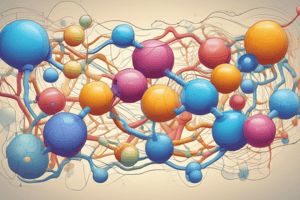Podcast
Questions and Answers
What is the energy currency of organisms?
What is the energy currency of organisms?
- ATP (correct)
- Glucose
- Pyruvate
- NAD+
Glycolysis occurs in the ______ of every cell.
Glycolysis occurs in the ______ of every cell.
cytosol
Which of the following are the three major stages of cellular respiration? (Select all that apply)
Which of the following are the three major stages of cellular respiration? (Select all that apply)
- Electron transfer/oxidative phosphorylation (correct)
- Acetyl CoA production (correct)
- Acetyl CoA oxidation (correct)
- Photosynthesis
How many ATP are produced from one glucose molecule in theory?
How many ATP are produced from one glucose molecule in theory?
What is the molecular mass of glucose?
What is the molecular mass of glucose?
Cellular respiration occurs in the cytoplasm only.
Cellular respiration occurs in the cytoplasm only.
The reduction of ______ is a feature of the glycolysis pathway.
The reduction of ______ is a feature of the glycolysis pathway.
What is produced during glycolysis?
What is produced during glycolysis?
Match the terms with their meanings:
Match the terms with their meanings:
Flashcards are hidden until you start studying
Study Notes
Overview of Glycolysis
- Glycolysis is the first stage of cellular respiration, occurring in the cytosol of all cells.
- It plays a crucial role in breaking down glucose into pyruvate, facilitating energy production.
Lecture Objectives
- Reintroduce the concept of cellular respiration.
- Understand the essential features of the glycolysis pathway, including:
- Reduction of NAD+ to NADH.
- Production of ATP.
- Formation of pyruvate.
- Identify vital steps in the glycolysis process.
- Explore alternative metabolic fates of pyruvate.
Stages of Cellular Respiration
- Cellular respiration comprises three major stages:
- Acetyl CoA production (glycolysis).
- Acetyl CoA oxidation (TCA cycle).
- Electron transfer and oxidative phosphorylation.
ATP Production Example
- From 5.45 grams of glucose, a calculation demonstrates the potential ATP yield:
- Molecular mass of glucose: 180.16 g/mol.
- Moles of glucose from 5.45 g: approximately 0.03025 moles.
- Total molecules of glucose: approximately 1.822 x 10^22 molecules.
- Each glucose molecule can produce up to 38 ATP molecules.
- Total ATP produced from this amount: approximately 6.92 x 10^23 ATP molecules, highlighting the extensive energy yield even at 50% efficiency.
Glycolysis Terminology
- The word "glycolysis" is derived from Greek:
- "Glykis" means sweet, referring to sugars.
- "Lysis" means splitting, indicating the breakdown process.
Locations of Key Metabolic Processes
- Glycolysis occurs in the cytoplasm.
- Acetyl CoA oxidation occurs in the mitochondrial matrix.
- Oxidative phosphorylation takes place in the inner mitochondrial membrane.
Importance of Metabolism
- Metabolism functions collectively, with the breakdown of carbohydrates being a foundational aspect.
- Other precursors for energy production include amino acids and glycerol, enhancing metabolic versatility.
Studying That Suits You
Use AI to generate personalized quizzes and flashcards to suit your learning preferences.




